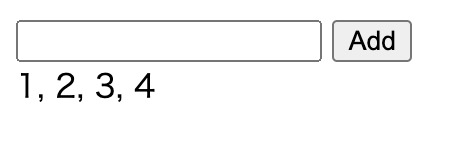Classic MVC and Reactive Programming, part 1
I recently found that Observable in RxJS is used as an event emitter in many places. From my point of view, Observable is kind of a value whose actual value changes synchronously or asynchronously.
I thought that I can demonstrate it by implementing a simple application with both classic MVC and RxJS, and compare them.
The application is pretty simple. It has one number input and a button, and displays a series of numbers you put into it. I’ll add some more functionalities gradually in the following posts.

Let’s implement this using classic MVC. We’ll define Model which manages values, ModelListener and ModelEvent to send events from Model to its listeners.
class Model {
get values(): number[] {
return [...this._values];
}
addValue(value: number): void {
this._values.push(value);
this.fireUpdated();
}
addListener(listener: ModelListener): void {
this._listeners.push(listener);
}
private fireUpdated(): void {
const event = new ModelEvent(this);
this._listeners.forEach(listener => listener.updated(event));
}
private _values: number[] = [];
private _listeners: ModelListener[] = [];
}
class ModelEvent {
constructor(readonly model: Model) {}
}
interface ModelListener {
updated(event: ModelEvent): void;
}
The controller listens to events from a model, and update views.
class Controller {
constructor(model: Model, document: HTMLDocument) {
const $value = document.getElementById('value') as HTMLInputElement;
const $add = document.getElementById('add') as HTMLInputElement;
const $view = document.getElementById('view') as HTMLInputElement;
$add.addEventListener('click', () => {
if ($value.value.length > 0) {
const v = Number($value.value);
if (!isNaN(v)) {
model.addValue(v);
}
}
$value.value = '';
});
model.addListener({
updated(event: ModelEvent): void {
$view.innerText = event.model.values.join(', ');
}
});
}
}
Now, we’ll create a model and a controller.
new Controller(new Model(), document);
This is pretty straightforward. How can you implement it using RxJS?
The first thing you need to do is to create an Observable using fromEvent, then convert each event to a series of values.
const values$ = fromEvent($add, 'click')
.pipe(
map(() => $value.value),
filter(value => value.length > 0),
map(value => Number(value)),
filter(value => !isNaN(value)),
scan((values, value, _) => [...values, value], [] as number[])
);
This values$ will be [1] when you input 1, then will be [1, 2] after you input 2, and so on. You can think this values$ represents the values you’ve inputted so far and the values will change on-the-fly. Don’t think this just as an event emitter.
Once you’ve subscribe to it, you can get the values to update views.
values$.subscribe(values => {
$view.innerText = values.join(', ');
$value.value = '';
});
You can find the complete code at snakamura/mvc_rx.
In the following posts, I’ll add some more features, such as saving, loading values to this application, and see how it’ll be implemented using both classic MVC and RxJS.